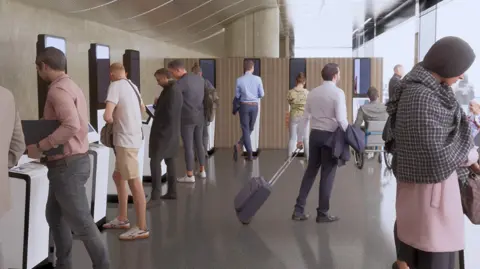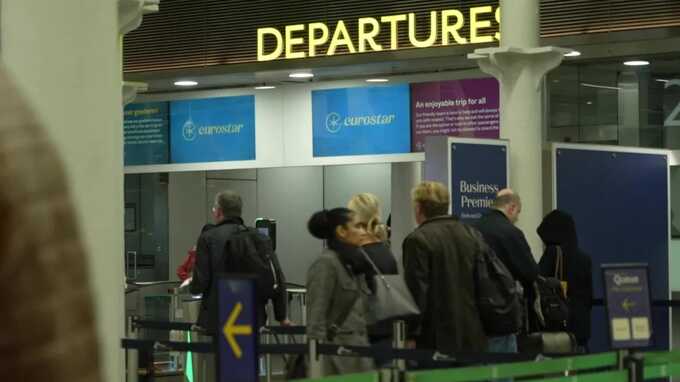Tens of millions spent ahead of new EU fingerprint travel rules
Preparations are under way at major Channel crossing points for a new automated European Union (EU) border IT system due to start this October, despite fears of queue chaos for holidaymakers.
Under the Entry Exit System (EES) non-EU nationals, including Brits, will have to register biometric information the first time they cross the border.
This has prompted concerns there might be huge delays as a result.
But tens of millions of pounds are being spent on equipment and processing areas at Dover’s ferry port, Eurostar’s London St Pancras terminus and Eurotunnel’s Folkestone site.
Dover plans to process coaches separately to cars and eventually reclaim a dock from the sea to create more space.
Eurostar will also expand into new areas of St Pancras station to fit in new kiosks.
People taking flights will provide the biometric information when they land at European airports.
However at Dover’s ferry port, Folkestone and London St Pancras, an arrangement of dual border controls means French border officers currently check and stamp passports as people leave the UK.
The new EES process will also take place on British soil at these sites.
Passports will no longer need to be stamped, but fingerprints and a photo will need to be taken. Travellers will also need to answer some questions about their journey.
As the registration process will need to be done in person at the port or station, there have been repeated warnings of bottlenecks as a result.
The UK Foreign Secretary David Cameron recently added his voice to concerns, telling a committee of MPs he was “really worried” about “long delays”.
Separate processes at Dover
Queueing at busy times is already an issue for space-constrained Dover.
The port’s chief executive Doug Bannister told the BBC its plans aimed to "minimise dwell times, queues and of course congestion out on the road network and throughout the town".
When EES kicks in, coaches - which carry dozens of passengers - will go to the Western docks, away from the main check-in areas. Coach halls will be built there, with new kiosks to register details.
Mr Bannister said passengers will then "proceed through the border in the Western docks, re-board their coach, the coach will get sealed, and it will come down here to the ferry terminal. As long as the seal’s intact the coach will proceed directly around to check-in."
There will be a different process for cars and other vehicles. To start with, they will file into the usual lanes upon arrival at the port.
The port boss said they will be "met by one of our agents with a tablet" and asked for their details. A canopy will be put up over the lanes for weather protection.
The time it takes to go through border controls is likely to rise from 45 to 90 seconds to a couple of minutes or more per person when registering for EES.
By summer next year, the hope is to relocate that car processing to the Western docks too. This relies on an old dock being filled in to create more land.
The port plans to create more holding space around the port by September 2027.
Coach companies are worried about the new system.
Roselyn Coaches is based in Cornwall. By the time its vehicles reach Dover, they have already been on the road for hours.
Commercial manager James Church said any extra delays at Dover would not only affect customers’ experience, but would also carry more costs because drivers could hit their hours limit.
"If you’ve got a full coach with 50 to 70 people on board, that takes quite a long time anyway," he told the BBC. "We’re quite concerned."
He added that the business didn’t want EES to end up putting "a negative thought on continental coach crossings".
Implementing EES at London St Pancras means a big change for Eurostar passengers taking trains to Paris and beyond.
The number of border control points in the existing departures area will be doubled. Space constraints won’t leave room for the EES kiosks as well.
So 49 of them will be installed at other points around the station, which is owned by HS1 and used by several domestic rail operators too.
A coffee shop near the main station entrance will make way for the main kiosk area. Two other zones will include an overflow room on St Pancras’ mezzanine level.

Simon Lejeune, Eurostar’s chief stations and security officer, insisted these arrangements, with extra staff on hand to assist customers, meant people would not need to turn up any earlier for a train than they currently do.
"With our set-up it will still be 45 to 90 minutes check-in time," he said.
"We’ve really planned intensely for this, making sure that we’ve got the best arrangement for our customers."
Eurostar’s preparations are costing the equivalent of £8.5m.
Eurotunnel, which operates freight and vehicle shuttles though the Channel Tunnel, is spending the equivalent of £70m building processing zones, where people will queue in their cars to use automatic machines.
It will also hire 70 new passenger assistance staff on each side of the channel.
The company’s boss Yann Leriche recently told the BBC getting through border controls would take five to seven minutes longer, but insisted the extra lanes and technology would avoid queues spilling out onto the roads.
The EU has been developing an app to enable EES registration to be started from home, but it’s not expected to be ready for the start of the new system.
However, for a six-month transition period, the EU is expected to allow the checks to be reduced in some circumstances if bad queues build up.
A spokesperson for the UK government said it was "working closely with the EU and member states to minimise any impact at our shared borders with Europe".
They added: "We are also working closely with the Kent Resilience Forum as well as with port authorities, ferry operators and industry to develop robust contingency plans to ensure they are prepared to minimise the risk of delays."
Read more similar news:
Comments:
comments powered by Disqus


































